Hybrid Nanofluid Flow Past a Shrinking Cylinder with Prescribed Surface Heat Flux
Abstract
1. Introduction
2. Mathematical Formulation
3. Stability Analysis
4. Results and Discussion
5. Conclusions
- For both shrinking cylinder and flat plate surfaces with the prescribed surface heat flux, the steady flow solutions are obtainable when the suction parameter is . No second solution was observed when considering the stretching surface.
- The separation of boundary layer can be decelerated by the extension of the critical value when . The flat plate surface also contributes to the maximum heat transfer rate.
- Among the three sets of hybrid AlO-Cu nanoparticle concentrations such that , , and , the hybrid nanofluids with concentration provided the greatest heat transfer rate and skin friction coefficient.
- The stability analysis mathematically supports the reliability of the first solution.
- The hybrid nanofluid flow due to the shrinking surfaces is a reverse (opposite) flow from the stretching surfaces. The velocity profile for the shrinking case shows a negative value and contradicts the positive velocity profile for the stretching case .
- The hybrid nanofluid temperature for the stretching case is lower than the shrinking case.
6. Recommendations for Future Work
- Different hybrid nanofluids (other stable combinations based on the experimental work of hybrid nanofluids);
- Stagnation point flow (exclusion of the wall mass suction parameter);
- Other physical parameters, such as magnetic field, thermal radiation, viscous dissipation and Joule heating.
Author Contributions
Funding
Acknowledgments
Conflicts of Interest
References
- Zokri, S.M.; Arifin, N.S.; Mohamed, M.K.A.; Salleh, M.Z.; Kasim, A.R.M.; Mohammad, N.F. Influence of radiation and viscous dissipation on magnetohydrodynamic Jeffrey fluid over a stretching sheet with convective boundary conditions. Malays. J. Fundam. Appl. Sci. 2017, 13, 279–284. [Google Scholar] [CrossRef]
- Khashi’ie, N.S.; Arifin, N.M.; Nazar, R.; Hafidzuddin, E.H.; Wahi, N.; Pop, I. Mixed convective flow and heat transfer of a dual stratified micropolar fluid induced by a permeable stretching/shrinking sheet. Entropy 2019, 21, 1162. [Google Scholar] [CrossRef]
- Kasim, A.R.M.; Arifin, N.S.; Zokri, S.M.; Salleh, M.Z. The investigation of a fluid-solid interaction mathematical model under combined convective jeffrey flow and radiation effect embedded newtonian heating as the thermal boundary condition over a vertical stretching sheet. Defect Diffus. Forum 2020, 399, 65–75. [Google Scholar] [CrossRef]
- Khashi’ie, N.S.; Arifin, N.M.; Rashidi, M.M.; Hafidzuddin, E.H.; Wahi, N. Magnetohydrodynamics (MHD) stagnation point flow past a shrinking/stretching surface with double stratification effect in a porous medium. J. Therm. Anal. Calorim. 2020, 139, 3635–3648. [Google Scholar] [CrossRef]
- Salleh, M.Z.; Mohamed, N.; Khairuddin, R.; Khasi’ie, N.S.; Nazar, R.; Pop, I. Free convection over a permeable horizontal flat plate embedded in a porous medium with radiation effects and mixed thermal boundary conditions. J. Math. Stat. 2012, 8, 122–128. [Google Scholar]
- Choi, S.U.; Eastman, J.A. Enhancing thermal conductivity of fluids with nanoparticles. ASME Fluids Eng. Div. 1995, 231, 99–105. [Google Scholar]
- Wang, Y.; Su, G.H. Experimental investigation on nanofluid flow boiling heat transfer in a vertical tube under different pressure conditions. Exp. Therm. Fluid Sci. 2016, 77, 116–123. [Google Scholar] [CrossRef]
- Wang, Y.; Deng, K.H.; Liu, B.; Wu, J.M.; Su, G.H. A correlation of nanofluid flow boiling heat transfer based on the experimental results of AlN/H2O and Al2O3/H2O nanofluid. Exp. Therm. Fluid Sci. 2017, 80, 376–383. [Google Scholar] [CrossRef]
- Ahmadi, M.; Willing, G. Heat transfer measurment in water based nanofluids. Int. J. Heat Mass Transf. 2018, 118, 40–47. [Google Scholar] [CrossRef]
- Masuda, H.; Ebata, A.; Teramae, K. Alteration of thermal conductivity and viscosity of liquid by dispersing ultra-fine particles. Netsu Bussei 1993, 4, 227–233. [Google Scholar] [CrossRef]
- Das, S.K.; Putra, N.; Thiesen, P.; Roetzel, W. Temperature dependence of thermal conductivity enhancement for nanofluids. J. Heat Transf. 2003, 125, 567–574. [Google Scholar] [CrossRef]
- Pak, B.C.; Cho, Y.I. Hydrodynamic and heat transfer study of dispersed fluids with submicron metallic oxide particles. Exp. Heat Transf. Int. J. 1998, 11, 151–170. [Google Scholar] [CrossRef]
- Kuznetsov, A.V.; Nield, D.A. Natural convective boundary-layer flow of a nanofluid past a vertical plate. Int. J. Therm. Sci. 2010, 49, 243–247. [Google Scholar] [CrossRef]
- Mahat, R.; Rawi, N.A.; Kasim, A.R.M.; Shafie, S. Mixed convection flow of viscoelastic nanofluid past a horizontal circular cylinder with viscous dissipation. Sains Malays. 2018, 47, 1617–1623. [Google Scholar] [CrossRef]
- Zokri, S.M.; Arifin, N.S.; Kasim, A.M.; Salleh, M.Z. Passive control of nanoparticles on MHD Jeffrey nanofluid past a convectively heated moving plate with thermal radiation. Int. J. Automot. Mech. Eng. 2018, 15, 5775–5792. [Google Scholar]
- Waini, I.; Ishak, A.; Pop, I. Dufour and Soret effects on Al2O3-water nanofluid flow over a moving thin needle: Tiwari and Das model. Int. J. Numer. Methods Heat Fluid Flow 2020. [Google Scholar] [CrossRef]
- Waini, I.; Ishak, A.; Pop, I. Hybrid nanofluid flow past a permeable moving thin needle. Mathematics 2020, 8, 612. [Google Scholar] [CrossRef]
- Waini, I.; Ishak, A.; Pop, I. Squeezed Hybrid Nanofluid Flow Over a Permeable Sensor Surface. Mathematics 2020, 8, 898. [Google Scholar] [CrossRef]
- Khashi’ie, N.S.; Arifin, N.M.; Pop, I. Mixed Convective Stagnation Point Flow towards a Vertical Riga Plate in Hybrid Cu-Al2O3/Water Nanofluid. Mathematics 2020, 8, 912. [Google Scholar] [CrossRef]
- Khashi’ie, N.S.; Arifin, N.M.; Pop, I.; Wahid, N.S. Flow and heat transfer of hybrid nanofluid over a permeable shrinking cylinder with Joule heating: A comparative analysis. Alex. Eng. J. 2020, 59, 1787–1798. [Google Scholar] [CrossRef]
- Zainal, N.A.; Nazar, R.; Naganthran, K.; Pop, I. Unsteady Three-Dimensional MHD NonAxisymmetric Homann Stagnation Point Flow of a Hybrid Nanofluid with Stability Analysis. Mathematics 2020, 8, 784. [Google Scholar] [CrossRef]
- Zainal, N.A.; Nazar, R.; Naganthran, K.; Pop, I. MHD flow and heat transfer of hybrid nanofluid over a permeable moving surface in the presence of thermal radiation. Int. J. Numer Methods Heat Fluid Flow 2020. [Google Scholar] [CrossRef]
- Zainal, N.A.; Nazar, R.; Naganthran, K.; Pop, I. MHD mixed convection stagnation point flow of a hybrid nanofluid past a vertical flat plate with convective boundary condition. Chin. J. Phys. 2020, 66, 630–644. [Google Scholar] [CrossRef]
- Yen, T.H.; Soong, C.Y.; Tzeng, P.Y. Hybrid molecular dynamics-continuum simulation for nano/mesoscale channel flows. Microfluid. Nanofluid. 2007, 3, 665–675. [Google Scholar] [CrossRef]
- Labib, M.N.; Nine, M.J.; Afrianto, H.; Chung, H.; Jeong, H. Numerical investigation on effect of base fluids and hybrid nanofluid in forced convective heat transfer. Int. J. Therm. Sci. 2013, 71, 163–171. [Google Scholar] [CrossRef]
- Nasrin, R.; Alim, M.A. Finite element simulation of forced convection in a flat plate solar collector: Influence of nanofluid with double nanoparticles. J. Appl. Fluid Mech. 2014, 7, 543–556. [Google Scholar]
- Takabi, B.; Shokouhmand, H. Effects of Al 2 O 3–Cu/water hybrid nanofluid on heat transfer and flow characteristics in turbulent regime. Int. J. Mod. Phys. C 2015, 26, 1550047. [Google Scholar] [CrossRef]
- Devi, S.S.U.; Devi, S.A. Numerical investigation of three-dimensional hybrid Cu–Al2O3/water nanofluid flow over a stretching sheet with effecting Lorentz force subject to Newtonian heating. Can. J. Phys. 2016, 94, 490–496. [Google Scholar] [CrossRef]
- Devi, S.S.U.; Devi, S.A. Heat transfer enhancement of Cu-Al2O3/water hybrid nanofluid flow over a stretching sheet. J. Niger. Math. Soc. 2017, 36, 419–433. [Google Scholar]
- Yousefi, M.; Dinarvand, S.; Yazdi, M.E.; Pop, I. Stagnation-point flow of an aqueous titania-copper hybrid nanofluid toward a wavy cylinder. Int. J. Numer. Methods Heat Fluid Flow 2018, 28, 1716–1735. [Google Scholar] [CrossRef]
- Hayat, T.; Nadeem, S.; Khan, A.U. Rotating flow of Ag-CuO/H 2 O hybrid nanofluid with radiation and partial slip boundary effects. Eur. Phys. J. E 2018, 41, 75. [Google Scholar] [CrossRef] [PubMed]
- Ghadikolaei, S.S.; Yassari, M.; Sadeghi, H.; Hosseinzadeh, K.; Ganji, D.D. Investigation on thermophysical properties of Tio2–Cu/H2O hybrid nanofluid transport dependent on shape factor in MHD stagnation point flow. Powder Technol. 2017, 322, 428–438. [Google Scholar] [CrossRef]
- Tayebi, T.; Chamkha, A.J. Buoyancy-driven heat transfer enhancement in a sinusoidally heated enclosure utilizing hybrid nanofluid. Comp. Therm. Sci. Int. J. 2017, 9, 405–421. [Google Scholar] [CrossRef]
- Ashorynejad, H.R.; Shahriari, A. MHD natural convection of hybrid nanofluid in an open wavy cavity. Results Phys. 2018, 9, 440–455. [Google Scholar] [CrossRef]
- Kasim, A.R.M.; Arifin, N.S.; Ariffin, N.A.N.; Salleh, M.Z.; Anwar, M.I. Mathematical model of simultaneous flow between casson fluid and dust particle over a vertical stretching sheet. Int. J. Integr. Eng. 2020, 12, 253–260. [Google Scholar]
- Lund, L.A.; Omar, Z.; Khan, U.; Khan, I.; Baleanu, D.; Nisar, K.S. Stability analysis and dual solutions of micropolar nanofluid over the inclined stretching/shrinking surface with convective boundary condition. Symmetry 2020, 12, 74. [Google Scholar] [CrossRef]
- Waini, I.; Ishak, A.; Pop, I. Hybrid nanofluid flow induced by an exponentially shrinking sheet. Chin. J. Phys. 2019, in press. [Google Scholar] [CrossRef]
- Anuar, N.S.; Bachok, N.; Arifin, N.M.; Rosali, H. Effect of Suction/Injection on Stagnation Point Flow of Hybrid Nanofluid over an Exponentially Shrinking Sheet with Stability Analysis. CDF Lett. 2019, 11, 21–33. [Google Scholar]
- Wang, C.Y. Fluid flow due to a stretching cylinder. Phys. Fluids 1988, 31, 466–468. [Google Scholar] [CrossRef]
- Mukhopadhyay, S. Mixed convection boundary layer flow along a stretching cylinder in porous medium. J. Pet. Sci. Eng. 2012, 96, 73–78. [Google Scholar] [CrossRef]
- Vajravelu, K.; Prasad, K.V.; Santhi, S.R. Axisymmetric magneto-hydrodynamic (MHD) flow and heat transfer at a non-isothermal stretching cylinder. Appl. Math. Comput. 2012, 219, 3993–4005. [Google Scholar] [CrossRef]
- Butt, A.S.; Ali, A. Entropy analysis of magnetohydrodynamic flow and heat transfer due to a stretching cylinder. J. Taiwan Inst. Chem. Eng. 2014, 45, 780–786. [Google Scholar] [CrossRef]
- Abbas, Z.; Rasool, S.; Rashidi, M.M. Heat transfer analysis due to an unsteady stretching/shrinking cylinder with partial slip condition and suction. Ain Shams Eng. J. 2015, 6, 939–945. [Google Scholar] [CrossRef]
- Malik, M.Y.; Salahuddin, T.; Hussain, A.; Bilal, S.; Awais, M. Homogeneous-heterogeneous reactions in Williamson fluid model over a stretching cylinder by using Keller box method. AIP Adv. 2015, 5, 107227. [Google Scholar] [CrossRef]
- Shafiq, A.; Khan, I.; Rasool, G.; Seikh, A.H.; Sherif, E.S.M. Significance of double stratification in stagnation point flow of third-grade fluid towards a radiative stretching cylinder. Mathematics 2019, 7, 1103. [Google Scholar] [CrossRef]
- Ganesan, P.; Loganathan, P. Magnetic field effect on a moving vertical cylinder with constant heat flux. Heat Mass Transf. 2003, 39, 381–386. [Google Scholar] [CrossRef]
- Ferdows, M.; Reddy, M.G.; Alzahrani, F.; Sun, S. Heat and Mass Transfer in a Viscous Nanofluid Containing a Gyrotactic Micro-Organism Over a Stretching Cylinder. Symmetry 2019, 11, 1131. [Google Scholar] [CrossRef]
- Ullah, I.; Alkanhal, T.A.; Shafie, S.; Nisar, K.S.; Khan, I.; Makinde, O.D. MHD Slip Flow of Casson Fluid along a Nonlinear Permeable Stretching Cylinder Saturated in a Porous Medium with Chemical Reaction, Viscous Dissipation, and Heat Generation/Absorption. Symmetry 2019, 11, 531. [Google Scholar] [CrossRef]
- Suleman, M.; Ramzan, M.; Ahmad, S.; Lu, D.; Muhammad, T.; Chung, J.D. A Numerical Simulation of Silver–Water Nanofluid Flow with Impacts of Newtonian Heating and Homogeneous–Heterogeneous Reactions Past a Nonlinear Stretched Cylinder. Symmetry 2019, 11, 295. [Google Scholar] [CrossRef]
- Muthtamilselvan, M.; Prakash, D. Unsteady hydromagnetic slip flow and heat transfer of nanofluid over a moving surface with prescribed heat and mass fluxes. Proc. Inst. Mech. Eng. Part J. Mech. Eng. Sci. 2015, 229, 703–715. [Google Scholar] [CrossRef]
- Jalilpour, B.; Jafarmadar, S.; Ganji, D.D.; Shotorban, A.B.; Taghavifar, H. Heat generation/absorption on MHD stagnation flow of nanofluid towards a porous stretching sheet with prescribed surface heat flux. J. Mol. Liq. 2014, 195, 194–204. [Google Scholar] [CrossRef]
- Waini, I.; Ishak, A.; Pop, I. On the stability of the flow and heat transfer over a moving thin needle with prescribed surface heat flux. Chin. J. Phys. 2019, 60, 651–658. [Google Scholar] [CrossRef]
- Kasim, A.R.M.; Mohammad, N.F.; Shafie, S.; Pop, I. Constant heat flux solution for mixed convection boundary layer viscoelastic fluid. Heat Mass Transf. 2013, 49, 163–171. [Google Scholar] [CrossRef]
- Waini, I.; Ishak, A.; Pop, I. Hybrid nanofluid flow and heat transfer past a vertical thin needle with prescribed surface heat flux. Int. J. Numer. Methods Heat Fluid Flow 2019, 29, 4875–4894. [Google Scholar] [CrossRef]
- Kasim, A.R.M.; Mohammad, N.F.; Shafie, S. Effect of heat generation on free convection boundary layer flow of a viscoelastic fluid past a horizontal circular cylinder with constant surface heat flux. AIP Conf. Proc. 2012, 1450, 286–292. [Google Scholar]
- Tiwari, R.K.; Das, M.K. Heat transfer augmentation in a two-sided lid-driven differentially heated square cavity utilizing nanofluids. Int. J. Heat Mass Transf. 2007, 50, 2002–2018. [Google Scholar] [CrossRef]
- Qasim, M.; Khan, Z.H.; Khan, W.A.; Shah, I.A. MHD boundary layer slip flow and heat transfer of ferrofluid along a stretching cylinder with prescribed heat flux. PLoS ONE 2014, 9, e83930. [Google Scholar] [CrossRef]
- Takabi, B.; Salehi, S. Augmentation of the heat transfer performance of a sinusoidal corrugated enclosure by employing hybrid nanofluid. Adv. Mech. Eng. 2014, 6, 147059. [Google Scholar] [CrossRef]
- Oztop, H.F.; Abu-Nada, E. Numerical study of natural convection in partially heated rectangular enclosures filled with nanofluids. Int. J. Heat Fluid Flow 2008, 29, 1326–1336. [Google Scholar] [CrossRef]
- Sankar Giri, S.; Das, K.; Kundu, P.K. Homogeneous–heterogeneous reaction mechanism on MHD carbon nanotube flow over a stretching cylinder with prescribed heat flux using differential transform method. J. Comput. Des. Eng. 2020, 7, 337–351. [Google Scholar] [CrossRef]
- Merkin, J.H. On dual solutions occurring in mixed convection in a porous medium. J. Eng. Math. 1986, 20, 171–179. [Google Scholar] [CrossRef]
- Weidman, P.D.; Kubitschek, D.G.; Davis, A.M.J. The effect of transpiration on self-similar boundary layer flow over moving surfaces. Int. J. Eng. Sci. 2006, 44, 730–737. [Google Scholar] [CrossRef]
- Harris, S.D.; Ingham, D.B.; Pop, I. Mixed convection boundary-layer flow near the stagnation point on a vertical surface in a porous medium: Brinkman model with slip. Transp. Porous Media 2009, 77, 267–285. [Google Scholar] [CrossRef]
- Suresh, S.; Venkitaraj, K.P.; Selvakumar, P.; Chandrasekar, M. Synthesis of Al2O3–Cu/water hybrid nanofluids using two step method and its thermo physical properties. Colloids Surf. Physicochem. Eng. Asp. 2011, 388, 41–48. [Google Scholar] [CrossRef]
- Khashi’ie, N.S.; Arifin, N.M.; Pop, I.; Nazar, R.; Hafidzuddin, E.H.; Wahi, N. Flow and heat transfer past a permeable power-law deformable plate with orthogonal shear in a hybrid nanofluid. Alex. Eng. J. 2020, 59, 1869–1879. [Google Scholar] [CrossRef]
- Bachok, N.; Ishak, A. Flow and heat transfer over a stretching cylinder with prescribed surface heat flux. Malays. J. Math. Sci. 2010, 4, 159–169. [Google Scholar]
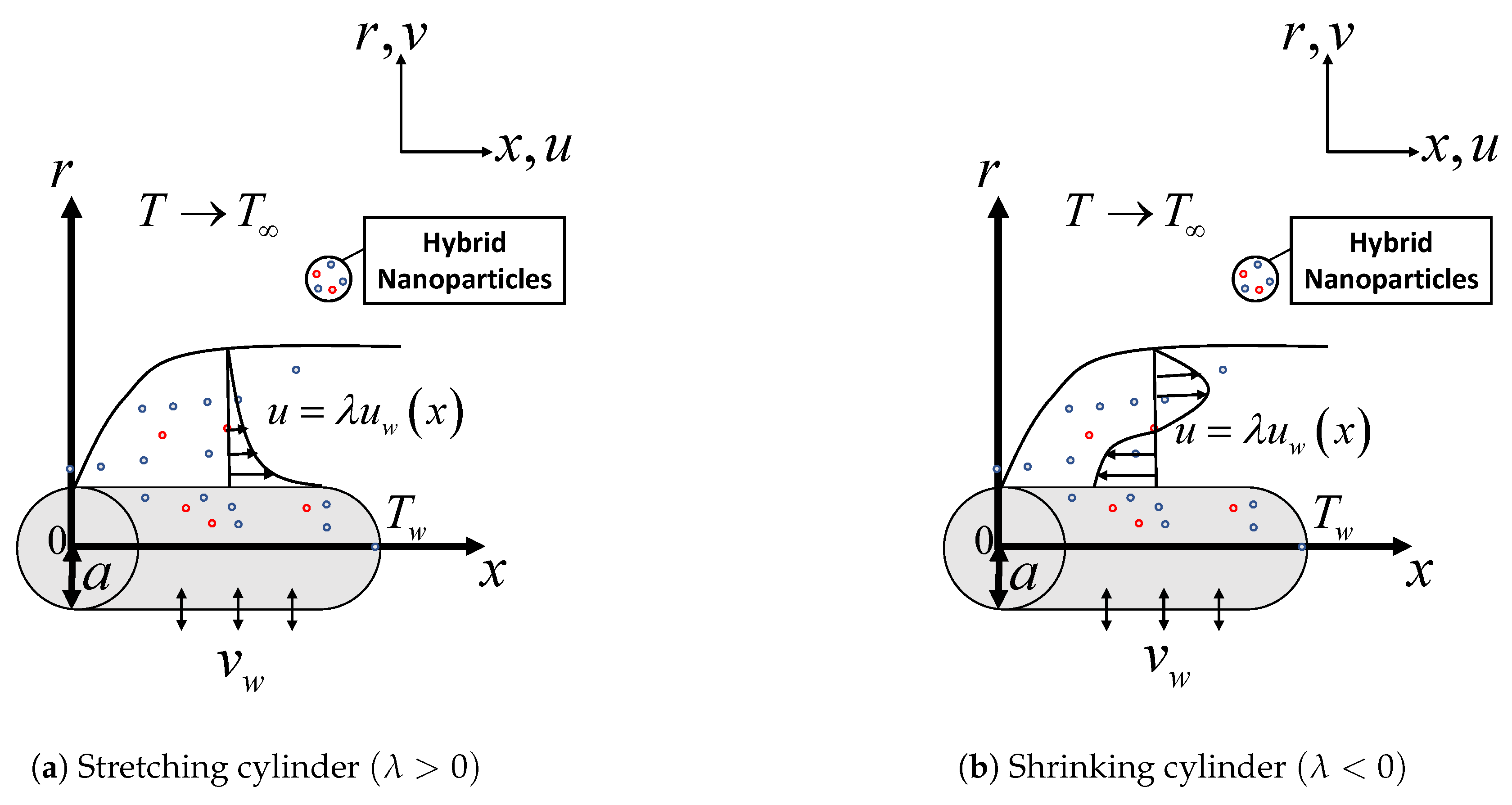

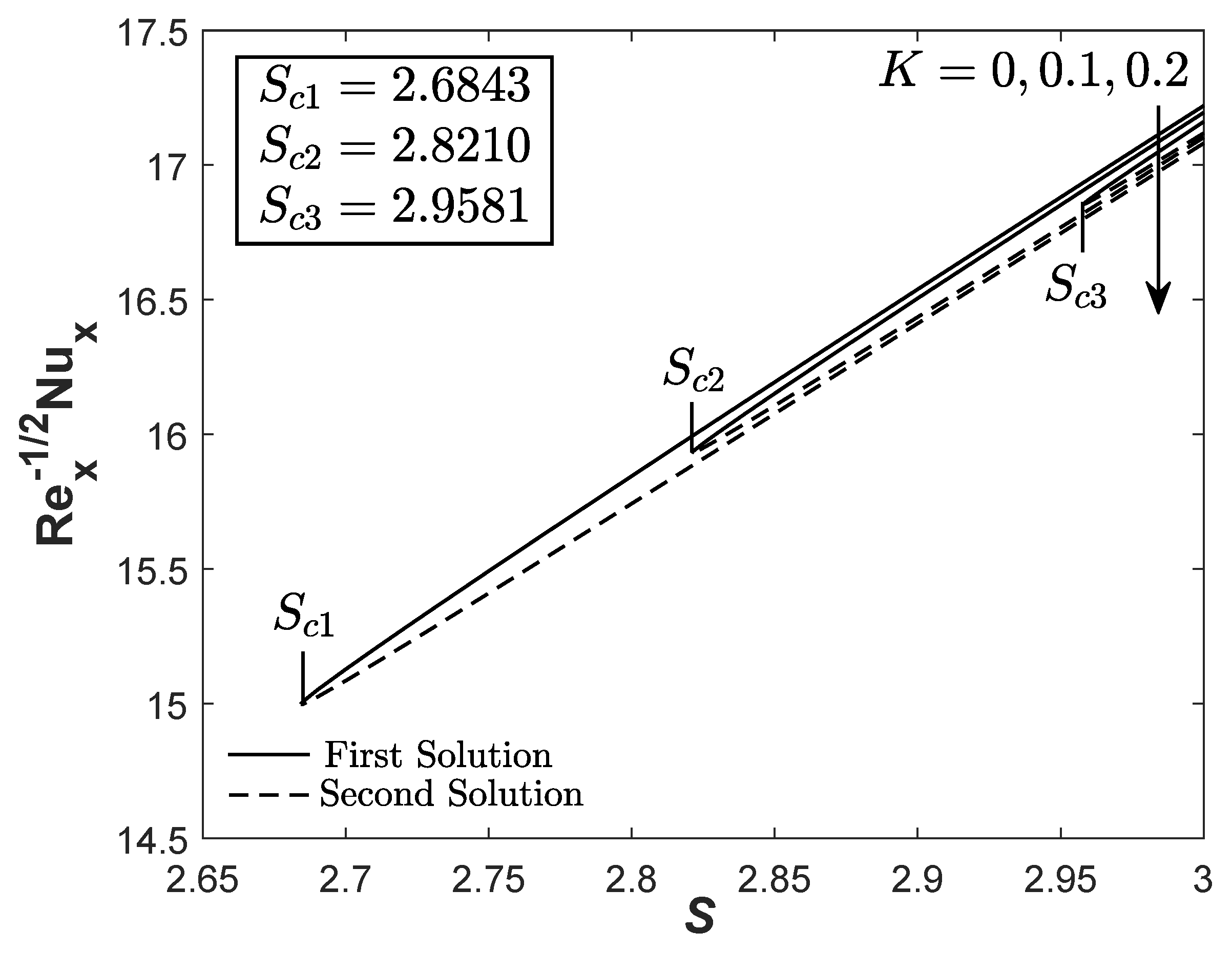
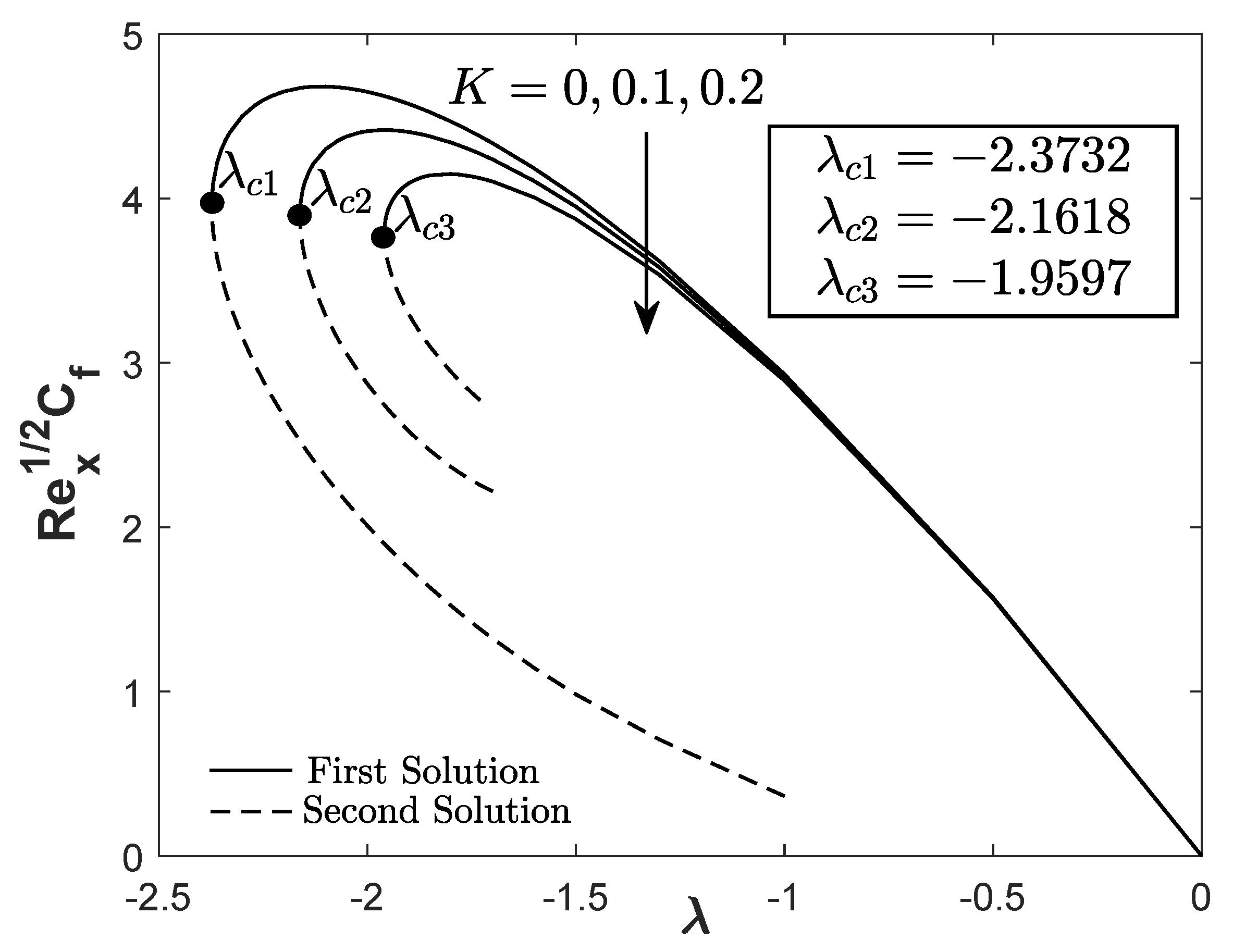
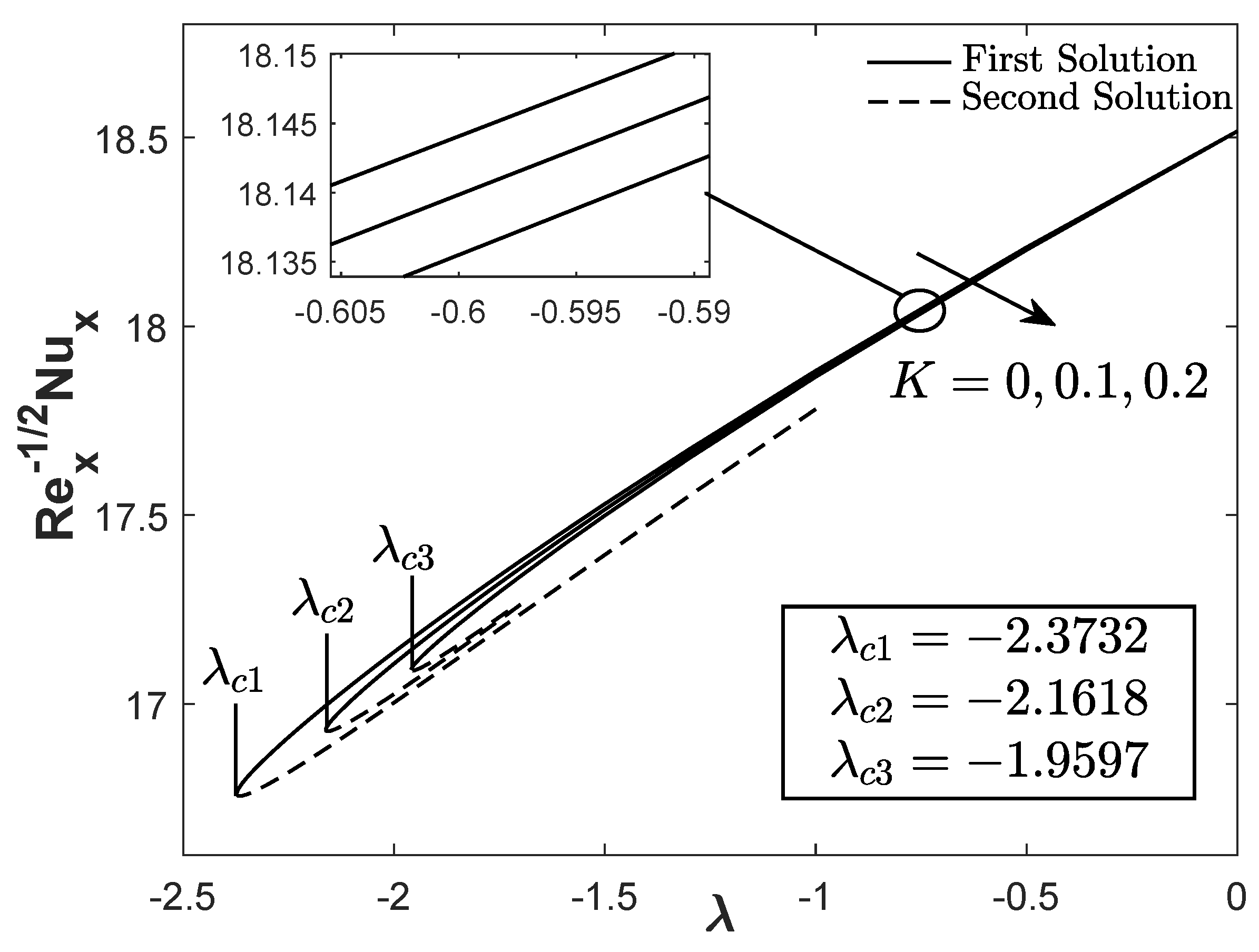
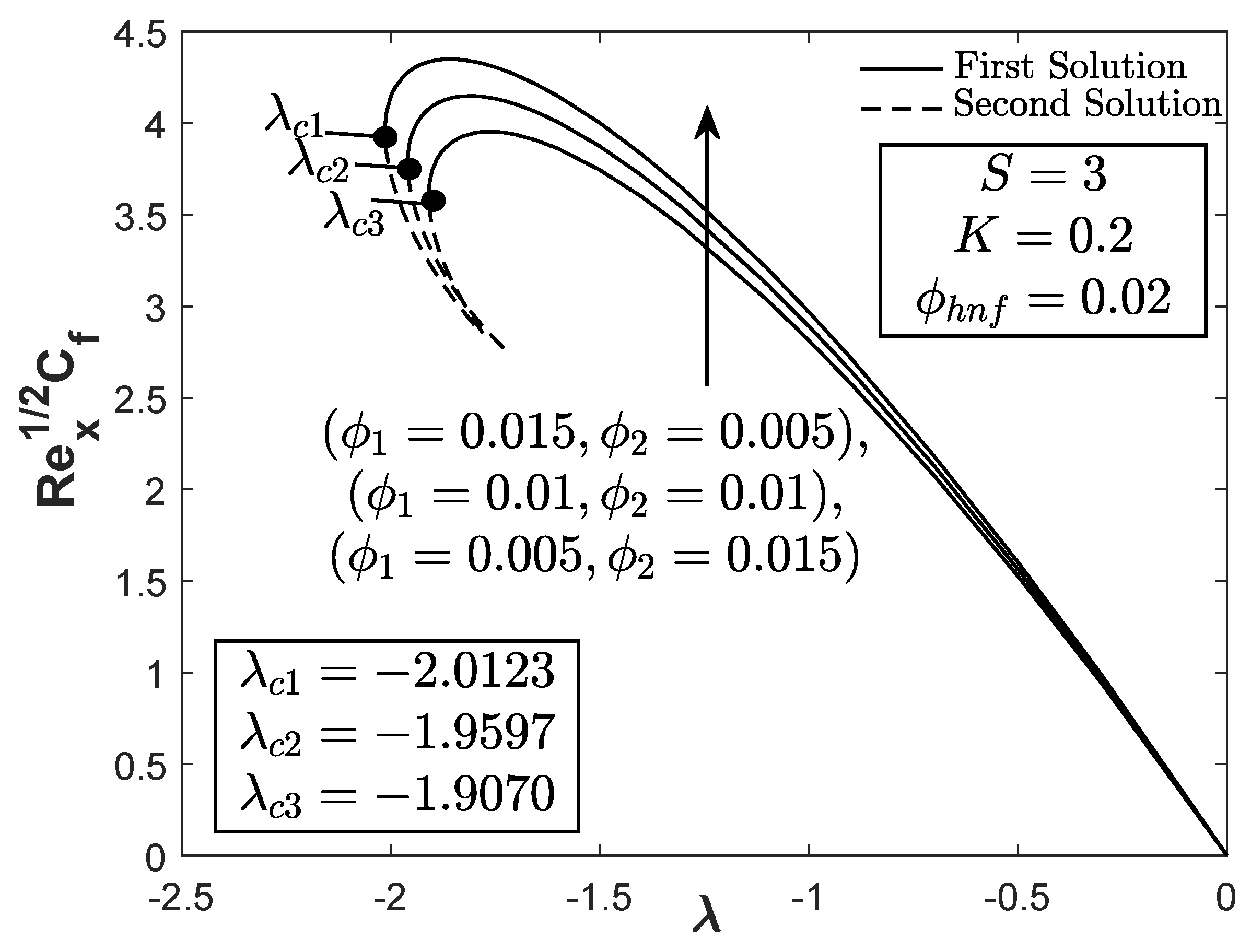
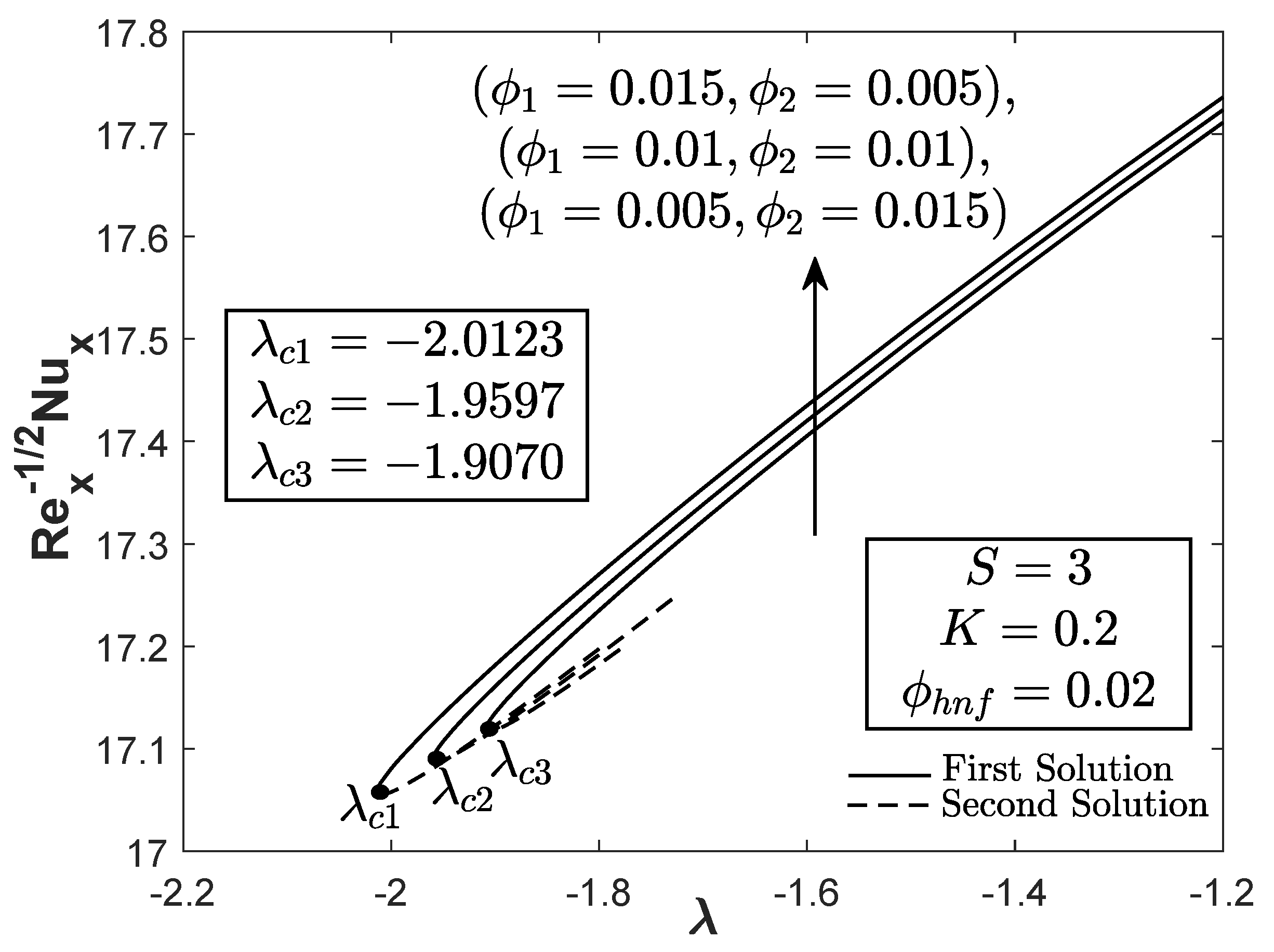
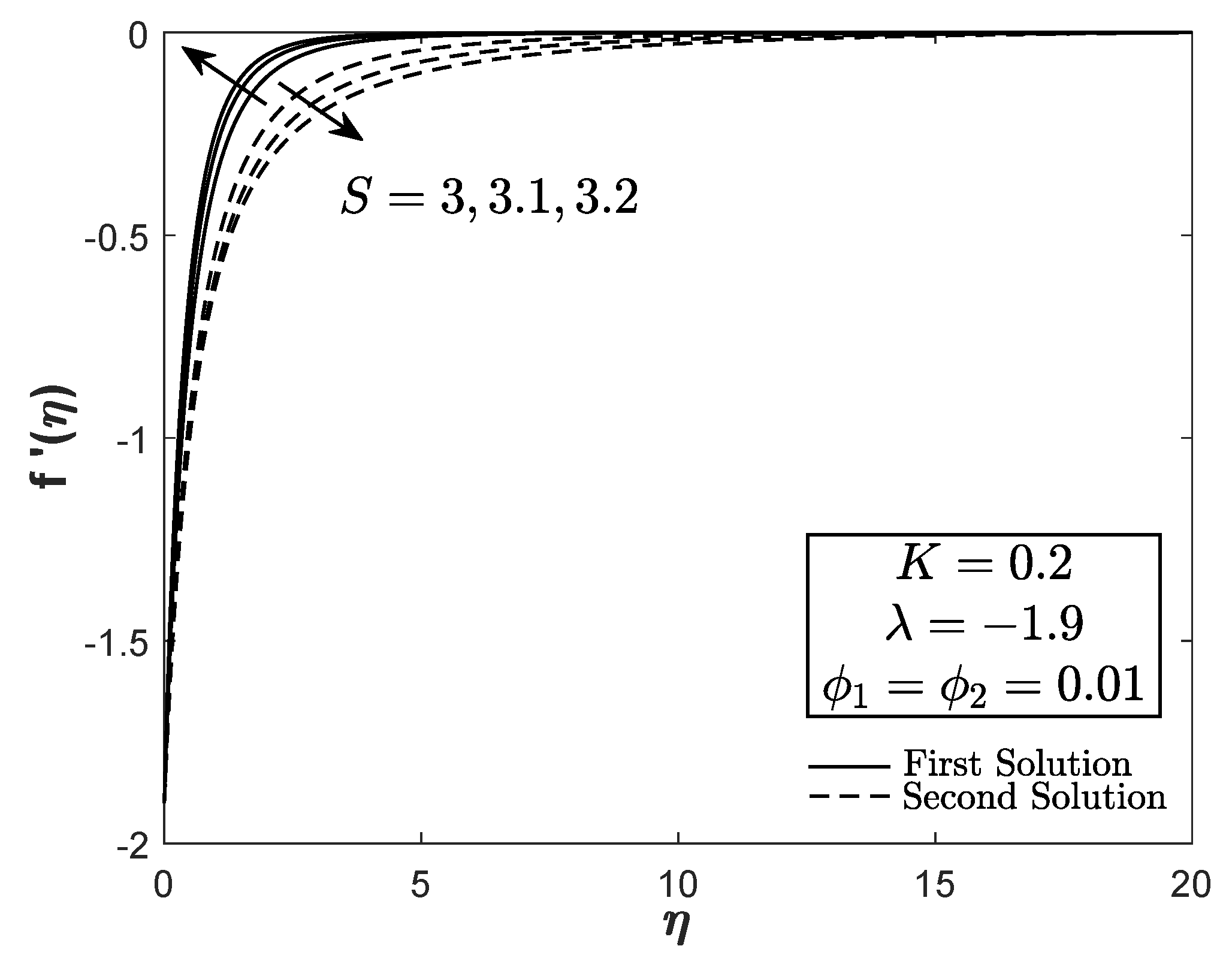
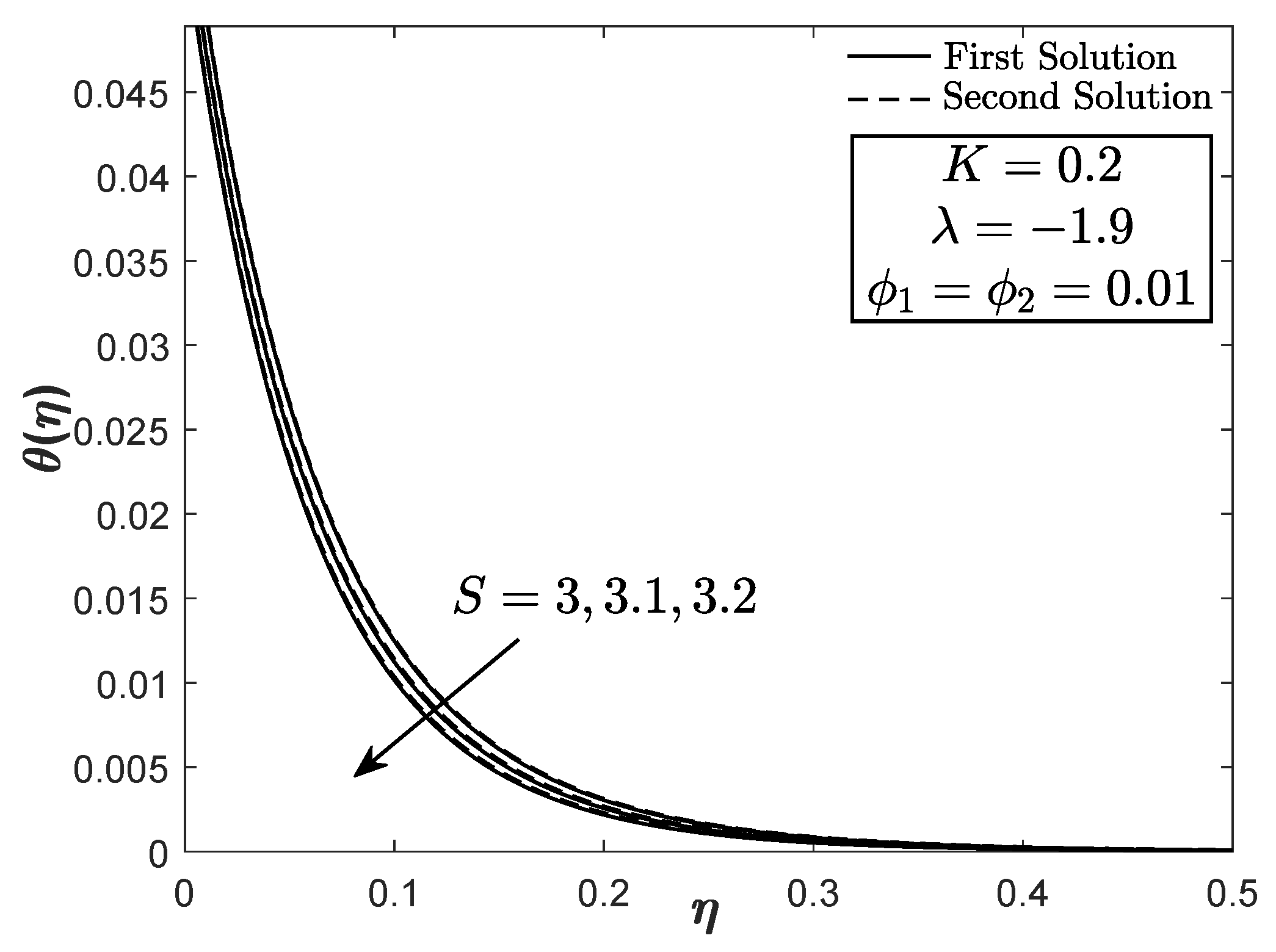


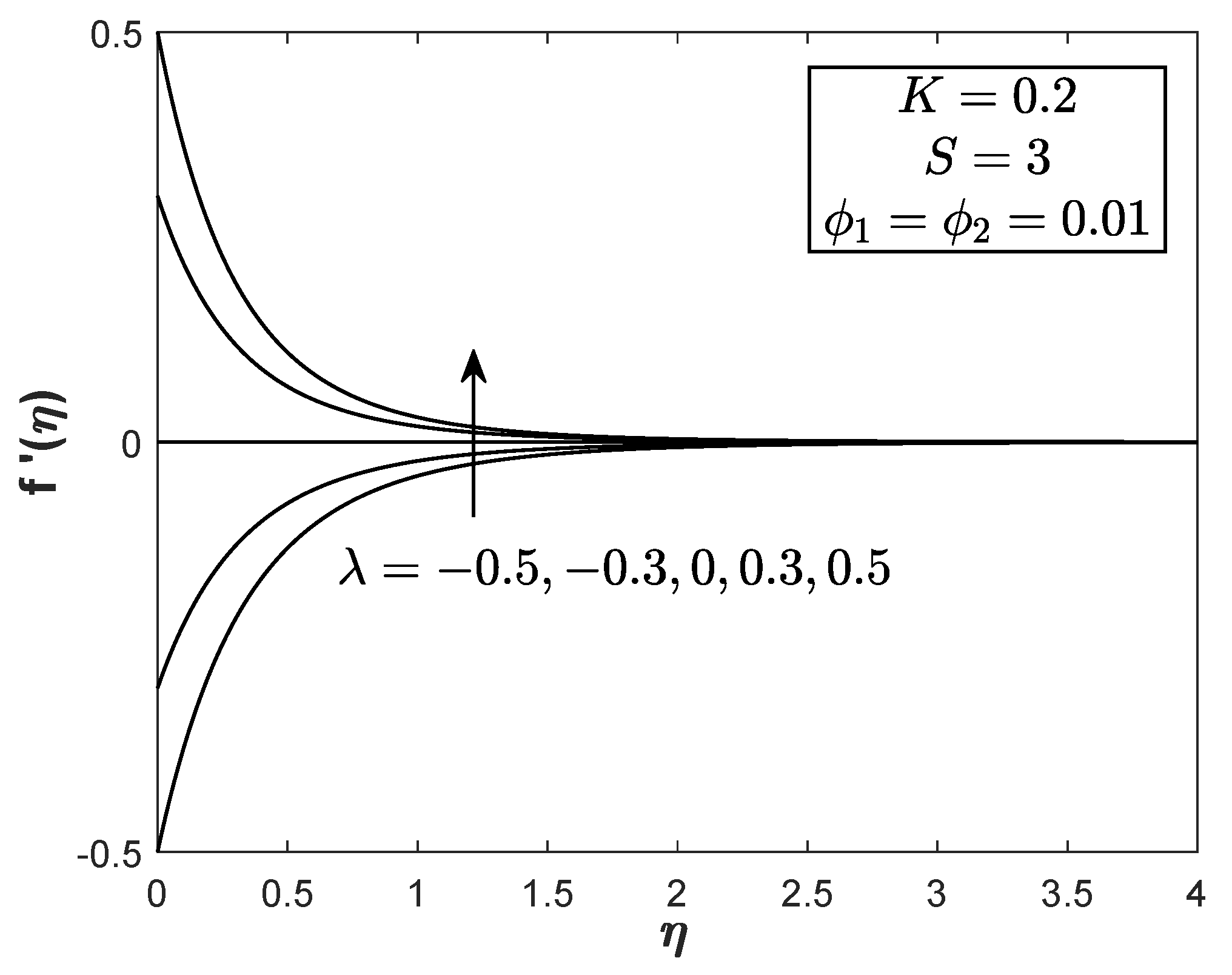
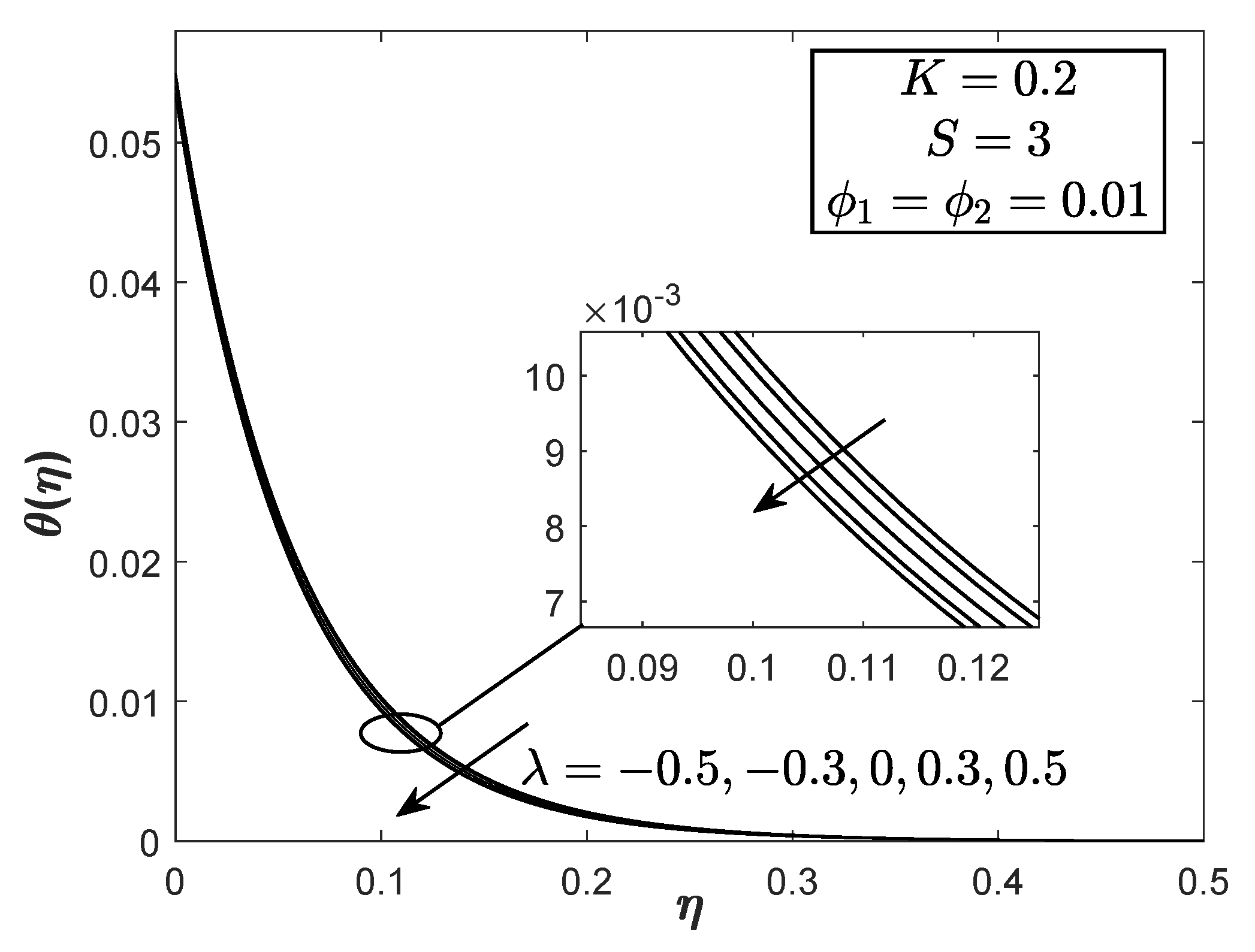
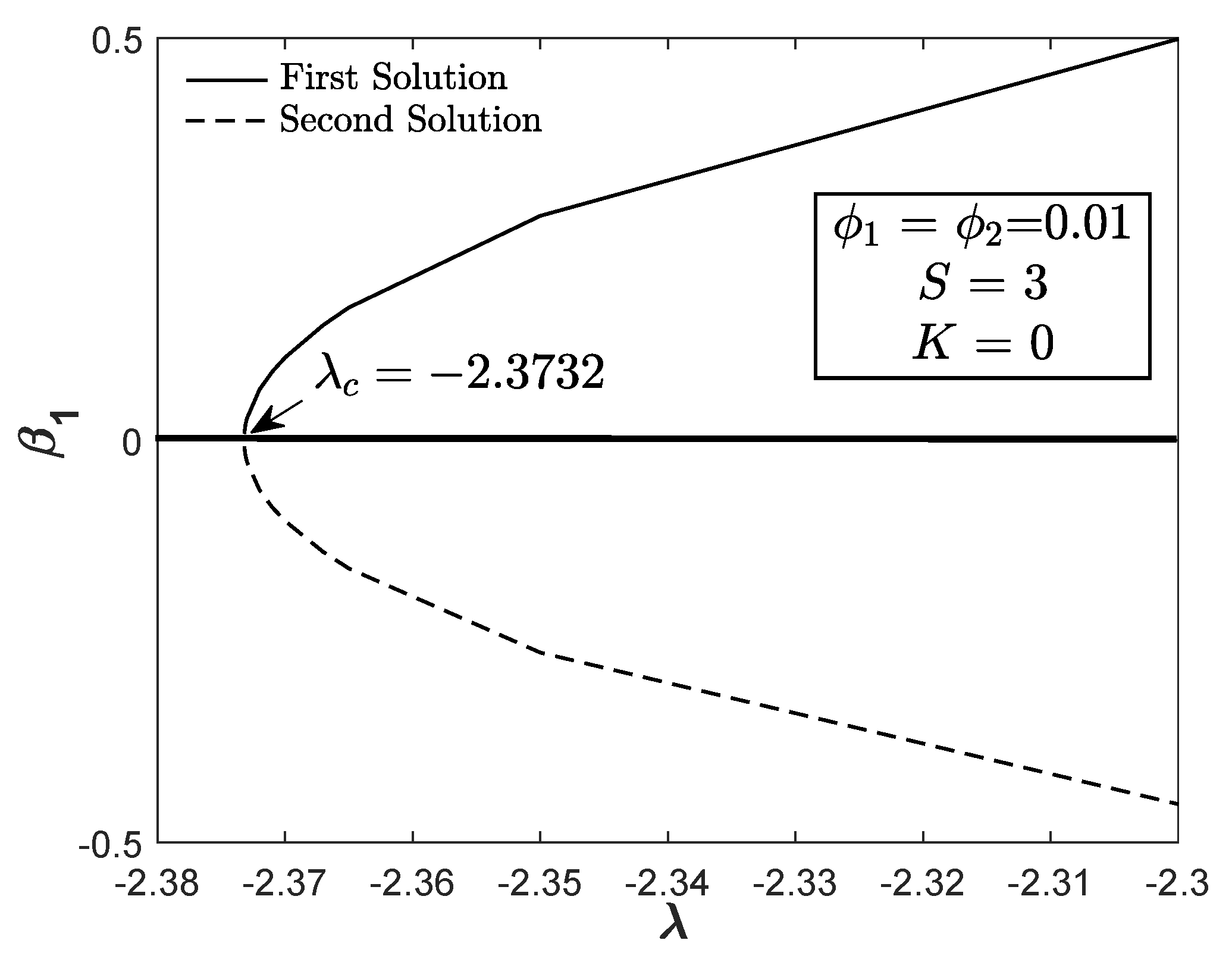
| Properties | Nanofluids |
|---|---|
| Density | |
| Heat Capacity | |
| Dynamic Viscosity | |
| Thermal Conductivity | |
| Thermophysical Properties | Base Fluid | Nanoparticles | |
|---|---|---|---|
| Pure Water | Alumina | Copper | |
| (J/kgK) | 4179 | 765 | 385 |
| (kg/m) | 997.1 | 3970 | 8933 |
| (W/mK) | 0.6130 | 40 | 400 |
| K | Pr | Present | Qasim et al. [57] | Bachok et al. [66] |
|---|---|---|---|---|
| 0.0 | 0.72 | 1.23666 | 1.23664 | 1.2367 |
| 1.0 | 1.00000 | 1.00000 | 1.0000 | |
| 6.7 | 0.33330 | 0.33330 | 0.3333 | |
| 10 | 0.26877 | 0.26876 | 0.2688 | |
| 1.0 | 0.72 | 0.87058 | 0.87018 | 0.8701 |
| 1.0 | 0.74395 | 0.74406 | 0.7439 | |
| 6.7 | 0.29653 | 0.29661 | 0.2966 | |
| 10.0 | 0.24412 | 0.24217 | 0.2442 |
| Present | Khashi’ie et al. [65] | |||
|---|---|---|---|---|
| First Solution | Second Solution | First Solution | Second Solution | |
| 0 | 2.594177 | 0.645222 | 2.594178 | 0.645222 |
| 0.01 | 2.781516 | 0.655350 | 2.781516 | 0.655350 |
| 0.02 | 2.967257 | 0.666893 | 2.967257 | 0.666894 |
| 0.03 | 3.151544 | 0.679725 | 3.151544 | 0.679725 |
© 2020 by the authors. Licensee MDPI, Basel, Switzerland. This article is an open access article distributed under the terms and conditions of the Creative Commons Attribution (CC BY) license (http://creativecommons.org/licenses/by/4.0/).
Share and Cite
Khashi’ie, N.S.; Waini, I.; Zainal, N.A.; Hamzah, K.; Mohd Kasim, A.R. Hybrid Nanofluid Flow Past a Shrinking Cylinder with Prescribed Surface Heat Flux. Symmetry 2020, 12, 1493. https://doi.org/10.3390/sym12091493
Khashi’ie NS, Waini I, Zainal NA, Hamzah K, Mohd Kasim AR. Hybrid Nanofluid Flow Past a Shrinking Cylinder with Prescribed Surface Heat Flux. Symmetry. 2020; 12(9):1493. https://doi.org/10.3390/sym12091493
Chicago/Turabian StyleKhashi’ie, Najiyah Safwa, Iskandar Waini, Nurul Amira Zainal, Khairum Hamzah, and Abdul Rahman Mohd Kasim. 2020. "Hybrid Nanofluid Flow Past a Shrinking Cylinder with Prescribed Surface Heat Flux" Symmetry 12, no. 9: 1493. https://doi.org/10.3390/sym12091493
APA StyleKhashi’ie, N. S., Waini, I., Zainal, N. A., Hamzah, K., & Mohd Kasim, A. R. (2020). Hybrid Nanofluid Flow Past a Shrinking Cylinder with Prescribed Surface Heat Flux. Symmetry, 12(9), 1493. https://doi.org/10.3390/sym12091493









